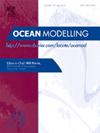Study on the influence of island chains on the vortex splitting of mesoscale eddies
IF 2.9
3区 地球科学
Q2 METEOROLOGY & ATMOSPHERIC SCIENCES
引用次数: 0
Abstract
In the ocean, there exist multi-scale water movements, among which mesoscale eddies are important carriers of oceanic material and energy transport. These vortices contain substantial kinetic energy and heat, playing a pivotal role in oceanic mass and energy transfer. The presence of islands can alter the movement path, intensity, and structure of vortices, and may even lead to vortex splitting. Vortex-island interactions not only affect local oceanic dynamic conditions but may also have broader impacts on large-scale ocean circulation and material transport. Previous multi-island studies have primarily focused on the range where the ratio of island spacing to mesoscale vortex diameter falls between 0.1 and 0.4. However, in real oceanic environments, cases where this ratio exceeds 0.4 are more common, particularly in multi-island regions such as the Lesser Antilles, where the ratio often reaches 0.6 or higher. To gain a more comprehensive understanding of the interaction mechanisms between island spacing and mesoscale vortices, as well as their dynamic processes across a broader range of ratios, this study employs the Regional Ocean Modeling System to conduct idealized numerical experiments. By varying parameters related to island configurations, we analyze the influence of islands on vortex trajectory and structural evolution, extending the investigation to cases with ratios ranging from 0.13 to 0.67. Based on the numerical simulation results, we propose a dimensionless function y that integrates three island-related variables, characterizing the impact of different island parameters on vortex splitting during vortex-island interactions.
岛链对中尺度涡旋涡分裂影响的研究
海洋中存在着多尺度的水运动,其中中尺度涡旋是海洋物质和能量输送的重要载体。这些涡旋含有大量的动能和热量,在海洋质量和能量传递中起着关键作用。岛屿的存在可以改变涡旋的运动路径、强度和结构,甚至可能导致涡旋分裂。涡岛相互作用不仅影响局部海洋动力条件,而且可能对大尺度海洋环流和物质运输产生更广泛的影响。以往的多岛研究主要集中在岛屿间距与中尺度涡旋直径之比在0.1 ~ 0.4之间的范围。然而,在真正的海洋环境中,这一比率超过0.4的情况更为常见,特别是在小安的列斯群岛等多岛屿地区,这一比率往往达到0.6或更高。为了更全面地了解岛屿间距与中尺度涡旋的相互作用机制及其在更大比例范围内的动力过程,本研究利用区域海洋模拟系统进行了理想化数值实验。通过改变岛屿构型的相关参数,分析了岛屿对涡旋轨迹和结构演变的影响,并将研究范围扩大到比值为0.13 ~ 0.67的情况。基于数值模拟结果,我们提出了一个包含三个岛相关变量的无量纲函数y,表征了涡-岛相互作用过程中不同岛参数对涡分裂的影响。
本文章由计算机程序翻译,如有差异,请以英文原文为准。
求助全文
约1分钟内获得全文
求助全文
来源期刊

Ocean Modelling
地学-海洋学
CiteScore
5.50
自引率
9.40%
发文量
86
审稿时长
19.6 weeks
期刊介绍:
The main objective of Ocean Modelling is to provide rapid communication between those interested in ocean modelling, whether through direct observation, or through analytical, numerical or laboratory models, and including interactions between physical and biogeochemical or biological phenomena. Because of the intimate links between ocean and atmosphere, involvement of scientists interested in influences of either medium on the other is welcome. The journal has a wide scope and includes ocean-atmosphere interaction in various forms as well as pure ocean results. In addition to primary peer-reviewed papers, the journal provides review papers, preliminary communications, and discussions.
 求助内容:
求助内容: 应助结果提醒方式:
应助结果提醒方式:


